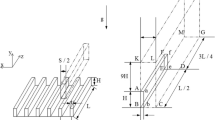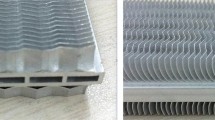Abstract
This research optimizes a heatsink fin wave that improves the cooling and heating efficiency in a Climate control seat (CCS). The design of existing CCS considers the occupant’s pressure, duct shape, blower blade shape, blower cogging torque, and mesh nozzles. However, the heatsink fin wave shape is overlooked in spite of its outstanding thermal efficiency. To address such problems, this research optimized the shape of the heatsink by defining the wave pitch, height pitch, and fin pitch. Parametric analysis (PA) was used such that the effective decision of the variables could be selected within each range of the variances. As a result, the cooling and the heating system operated more efficiently and the time required to reach the target temperature was reduced when compared to the existing system. The performance of the CCS was demonstrated by simulations and experiments.
Similar content being viewed by others
References
N. Wolfe, X. Mu, L. Huang and P. Kadle, Cooling with augmented heated and cooled seats, SAE Technical Paper 2007-01-1193 (2007).
L. Zhao, C. Zhou and Y. Yu, Hybrid modeling of seat-cab coupled system for truck, International J. of Automotive Technology, 17 (5) (2016) 769–776.
J. H. Jung, S. C. Kim, J. P. Won, S. H. Noh and Y. S. Cho, A experimental study on the performance of climate control seats using the discharge port of the shape of nozzle, Transaction of the Korean Society of Automotive Engineers, 17 (3) (2009) 110–116.
J. A. Lustbader, Evaluation of advanced automotive seats to improve thermal comfort and fuel economy, Evaluation, 1 (2005) 2056.
J. Fairbanks, Thermoelectric applications in vehicles status 2008, US Department of Energy (2008).
D. Lee, T. Park, S. Chung, C. Jeong and Y. Wang, Experimental study of cooling and heating performance of HVAC connected climate control seats, 2015 KSAE (2015) 315–321.
D. Chang, A study on seat system in automotive airconditioning ventilation control for high-performance, lownoise optimal design alternatives, Master's Degree, Hanyang University, Seoul (2014).
Ho-Sun Cho, Flow characteristic improvement and performance evaluation of ventilation seat duct flux through computational fluid dynamics and experiment, J. of Korean Soc. of Mechanical Technology, 16 (5) (2014) 1833–1838.
K. Yongman, C. Sukmin and L. Seungjoon, Permeability evaluation for ventilation and climate control seat (2013) 2030–2036.
C.-C. Wang, C.-I. Hung and W.-H. Chen, Design of heat sink for improving the performance of thermoelectric generator using two-stage optimization, Energy, 39 (1) (2012) 236–245.
R. J. Buist and M. J. Nagy, Thermoelectric heat sink modeling and optimization, AIP Conference Proceedings (1995) 135-135.
D. Demirocak, Thermodynamic and economic analysis of a solar thermal powered adsorption cooling system, Unpublished M.Sc. Thesis, Middle East Technical University, Turkey (2008).
J. T. Jarman, E. E. Khalil and E. Khalaf, Energy analyses of thermoelectric renewable energy sources, Open Journal of Energy Efficiency (2013).
U. S. D. O. Energy (02.05), Principles of Heating and Cooling, http://energy.gov/energysaver/principles-heating-andcooling.
S. Daly, Automotive air conditioning and climate control systems, Butterworth-Heinemann (2011).
J. Dong, J. Chen, W. Zhang and J. Hu, Experimental and numerical investigation of thermal-hydraulic performance in wavy fin-and-flat tube heat exchangers, Applied Thermal Engineering, 30 (11) (2010) 1377–1386.
S.-Y. Wu, B.-X. Cao, L. Xiao and Y.-R. Li, Parametric study on flow and heat transfer characteristics of porous wick evaporator based on AMTEC, J. of Mechanical Science and Technology, 26 (3) (2012) 973–981.
J.-H. Park, H.-I. Koh and N.-P. Kim, Parametric study of lateral stability for a railway vehicle, J. of Mechanical Science and Technology, 25 (7) (2011) 1657–1666.
Author information
Authors and Affiliations
Corresponding author
Additional information
Recommended by Associate Editor Chang Yong Park
Minjae Kim received his B.S. and M.S. degrees from the Department of Electrical Engineering at Seoul National University in 2008 and 2010, respectively. He obtained his Ph.D. degree from Seoul National University in 2014. He is now a Professor in the School of Mechanical Engineering at Myongji University.
Rights and permissions
About this article
Cite this article
Lee, J., Rew, K., Lee, C. et al. A study on heatsink fin wave optimization for climate control seat. J Mech Sci Technol 31, 1489–1495 (2017). https://doi.org/10.1007/s12206-017-0248-4
Received:
Revised:
Accepted:
Published:
Issue Date:
DOI: https://doi.org/10.1007/s12206-017-0248-4




